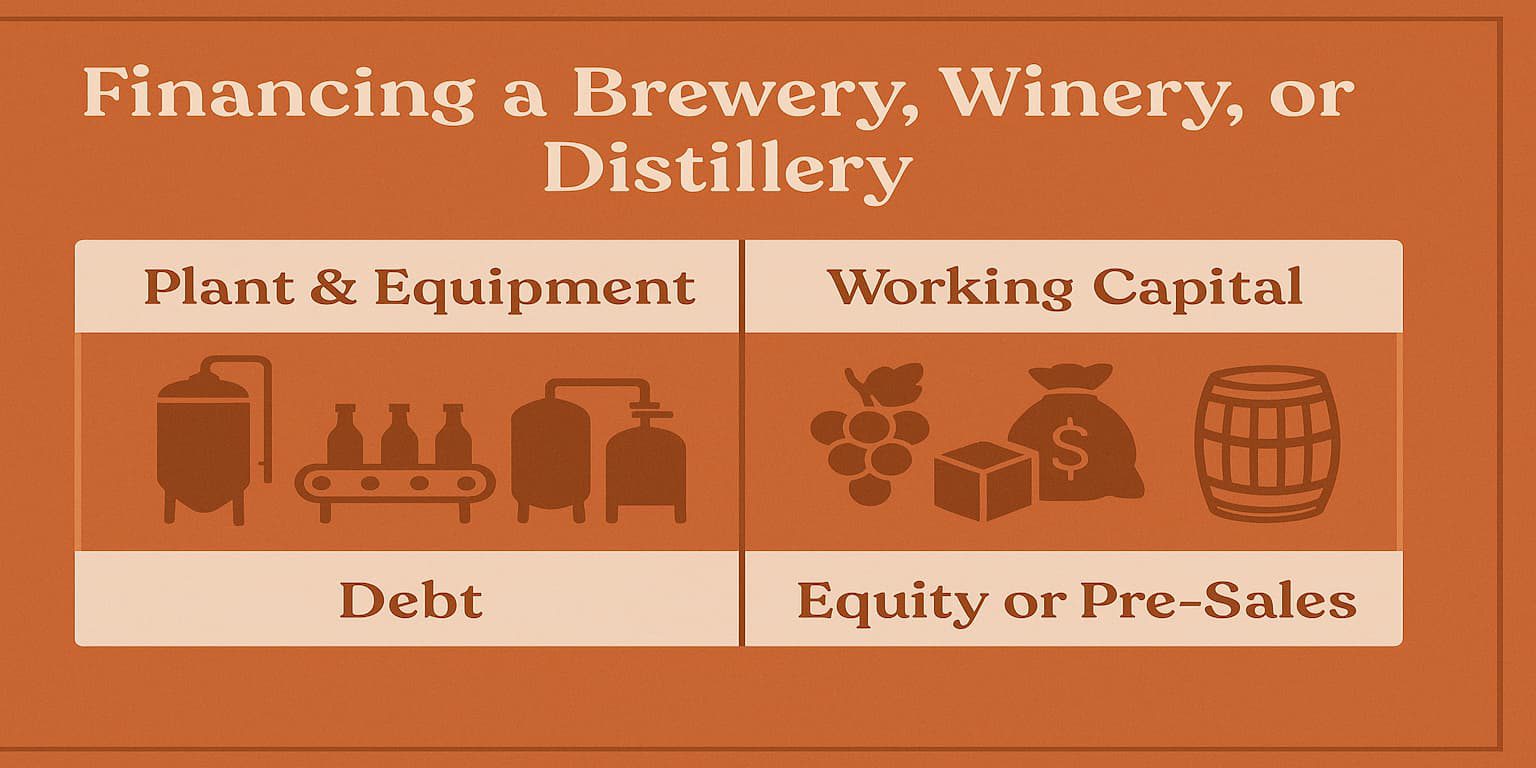Starting and growing a brewery, winery, or distillery is a capital-intensive venture. Beyond the obvious need for equipment and facilities—such as fermenters, stills, bottling lines, and cellar space—alcohol producers must also finance significant working capital. Ingredients, packaging, marketing campaigns, and perhaps most critically, inventory that sits aging in barrels for years before it generates revenue, all require funding upfront.
This dual need—capital expenditure (CapEx) for long-term assets and working capital for short-term liquidity—demands thoughtful financial planning. The way you finance your business can shape your cash flow, ownership structure, risk profile, and long-term viability.
This article helps you understand the differences between debt, equity, and alternative financing strategies. It breaks down when and why each option might suit a particular need—whether you’re installing a bottling line or buying grapes for next year’s vintage—and offers alcohol-specific insights to guide your decision.
Plant & Equipment vs. Working Capital: Different Needs, Different Financing
Before diving into funding options, it’s worth understanding the distinction between plant and equipment investment versus working capital.
Plant and equipment—like fermenters, tanks, and bottling lines—are long-term, tangible assets. They typically retain some value and are easy to use as collateral, making them well-suited for debt financing if you do not have levels of equity available.
On the other hand, working capital often includes expenses that can’t be secured against—such as yeast, grapes, packaging materials, or even barrels of aging spirits that won’t see a financial return for years. For these needs, if you do not have equity financing available or want to explore other options like unsecured debt, pre-sales, or supplier partnerships may be a better fit.
Debt Financing: Keep Ownership, But Mind the Repayments
Debt financing involves borrowing money that you agree to pay back over time with interest. This could come in the form of a bank loan, business line of credit, or equipment lease.
Why choose debt?
- You maintain full ownership of your business.
- Loan interest is often tax-deductible.
- Repayments are predictable, making budgeting easier.
But there’s a catch.
- You’ll owe money regardless of how well your business is doing.
- If sales are delayed (common with aged wines or spirits), repayments can become a burden.
- You’ll likely need strong credit and/or collateral to qualify.
For fixed assets like bottling lines or delivery vehicles, debt is often the most efficient option. These are tangible, depreciable assets that lenders are comfortable financing.
Equity Financing: Share the Risk, Share the Reward
Equity financing involves raising capital by selling shares in your business. This could be through private investors, venture capital, crowdfunding platforms, or by bringing in new business partners.
Why consider equity?
- There are no monthly repayments, which helps with cash flow—especially useful when your product takes time to age or develop.
- Investors share in the risk, and may bring experience, contacts, or strategic input.
- Crowdfunding options like Snowball Effect or Equitise can turn loyal fans into shareholders.
However…
- You give up a portion of ownership and control.
- Investors expect returns, whether via dividends, growth, or eventual sale.
- Negotiating and managing these relationships can be time-consuming.
Equity is particularly helpful when financing inventory that won’t convert to cash for years—such as cask-aged whisky or wine. It provides breathing room to let your product mature without the pressure of looming repayments.
Joint Ventures and Alternative Financing
In the drinks industry, collaboration can be a smart way to access capital without taking on traditional debt or giving up equity. Joint ventures—such as profit-sharing or deferred payment agreements with grape growers or suppliers—can ease cash flow while aligning both parties toward a shared goal.
Supplier financing works similarly, allowing producers to delay payments or share production costs with partners like bottlers or distributors. These arrangements are especially useful when trust and long-term alignment exist.
Revenue-based financing offers flexibility by tying repayments to a percentage of monthly revenue, making it ideal for businesses with fluctuating income. There are services that accelerate the payment of sales revenue i.e. getting paid by a factoring service before the customer pays you.
Pre-sales and crowdfunding have gained traction as flexible, brand-friendly ways to raise capital—especially for working capital needs. Some examples include:
- Crowdfunding platforms like Kickstarter to fund new product lines.
- En primeur sales of wine, where customers pay upfront for bottles delivered later.
- Cask sales of spirits—customers buy a barrel that matures over time, creating an early cash injection.
Making the Right Choice: How Alcohol Producers Should Decide
There’s no universal best choice—your financing strategy depends on your goals, timeline, and risk tolerance. It’s common to use a hybrid approach. Some rules of thumb apply:
|
Scenario |
Good Options |
|
Buying equipment or vehicles |
Debt (secured against the asset) |
|
Funding inventory that ages over time |
Equity or pre-sales |
|
Maintaining full control |
Debt |
|
Launching with no credit history |
Equity or crowdfunding |
|
Seasonal business with uneven cash flow |
Equity or revenue-based financing |
|
Working with loyal customers or a strong brand story |
Pre-sales or crowdfunding |
Build a Strategy That Ages Well
In conclusion, financing an alcohol business isn’t just about getting cash—it’s about setting your business up for long-term sustainability. Whether you’re buying stainless steel tanks or filling your first barrels, the right type of funding depends on the nature of the investment, your stage of growth, and your vision for the future.
Debt can preserve control but adds pressure. Equity can be freeing but dilutes your stake. Pre-sales and partnerships can unlock creativity and community. The best strategies often combine multiple sources, tailored to your unique needs.






